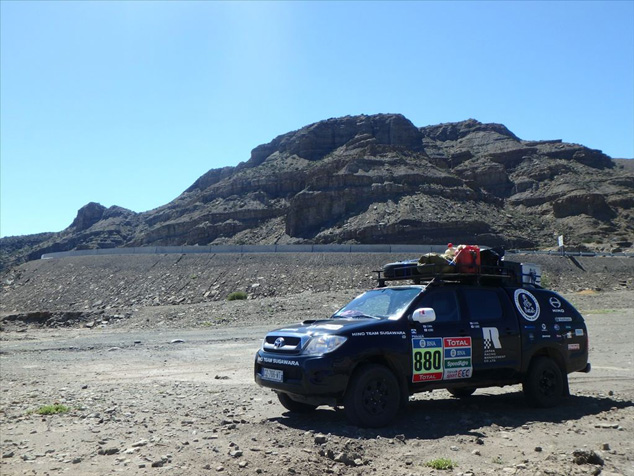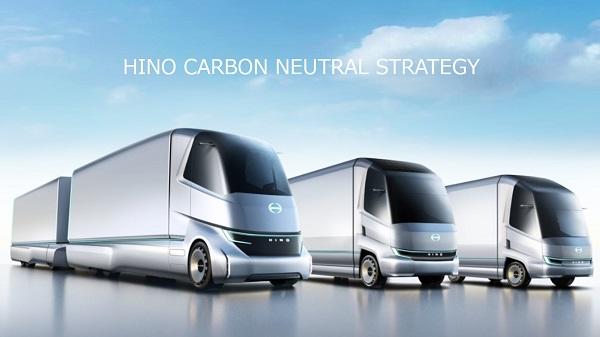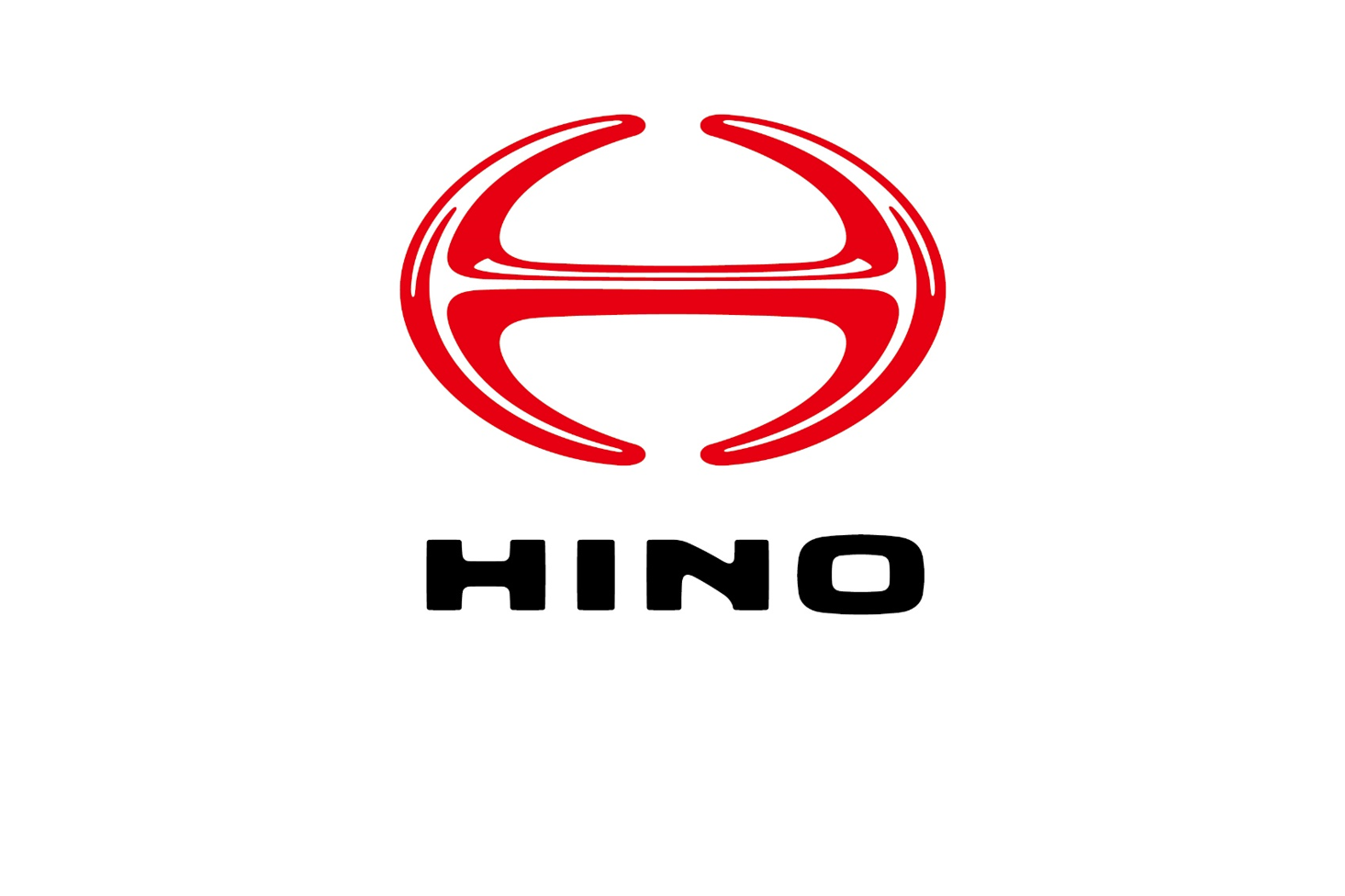“We’re going all the way to support the team.” HINO TEAM SUGAWARA support team interview
Nov 15, 2016
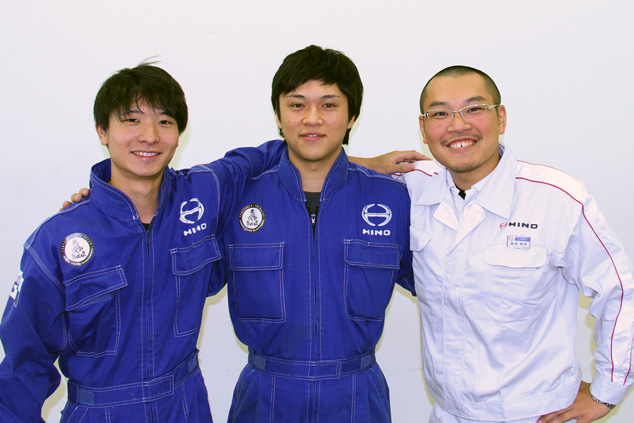
and Mr. Shimazaki from Hino Motors Technical Research Center.
In this issue of Dakar Rally News, we spoke with three HINO TEAM SUGAWARA members on topics such as the role support members play and how they got to be on the team, as well as their ambitions for the upcoming Dakar Rally in January 2017. Please send your support to these dedicated professionals who support the team behind the scenes!
― What role do support members play on the team?
Tanaka: Since the trucks’ pre-rally servicing is done in the host country, the first thing for me is that we need to go out and purchase items locally if any of the supplies we bring from Japan become damaged or we run short. We may not know where to find certain items, so we search the internet or ask the locals, and the language barrier is a challenge. If we can’t convey our needs, we won’t know where to go to buy these things, so we study some rudimentary Spanish and use dictionaries to get our intentions across.
Shimazaki: Based on my experience last year, I also felt there was a huge language barrier in the host countries. Some people were very kind to the point that if they saw we could only converse using individual words, they would go out of their way to explain routes and other matters using just individual words. But not everyone is like that, and some people couldn’t be bothered.
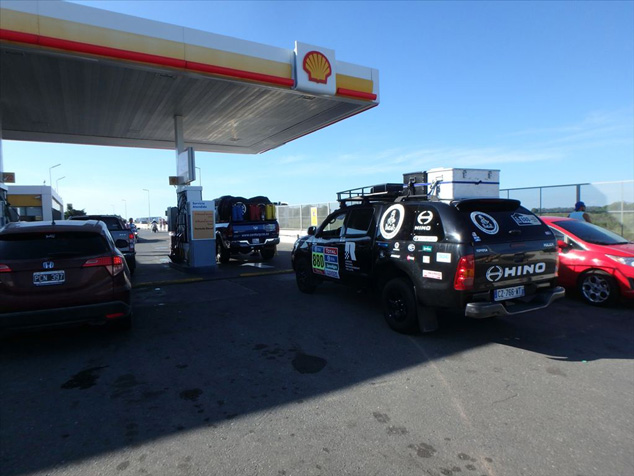
― What happens once the rally starts?
Tanaka: I’m a support car driver, so once the rally is underway, my job is to drive all the mechanics to their bivouacs each day.
Shimazaki: Local vehicles are left-hand drive, and the traffic signs are different from Japan, so we’re sure to review those things before we leave. But even with that kind of preparation, I had to be on my toes for the first little while until I became accustomed to those differences. Another thing is that we need to calculate our remaining fuel supply and determine our next refueling point, as there aren’t that many places along the way where we can get fuel. While we would like to arrive at the bivouac with as full a tank as possible, the same goes for all the other teams, which means the gas stations nearest to the bivouac will be very crowded. It’s things like these that we need to keep in mind when deciding where to refuel.
Tanaka: The mechanics work through the night till morning, and the only time they can get sleep is while they’re being transported in our cars, so I pay close attention to how I drive.
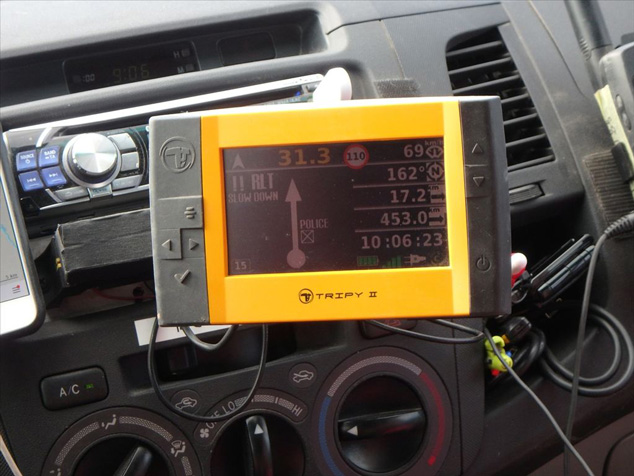
Shimazaki: We have the mechanics on board as well as team equipment, so we can’t drive rough. We haven’t had any problems with Hino’s support cars so far, but we know other teams have had problems. For example, there was this one car with its brakes giving off smoke on a mountain pass, and I’ve seen as many as three or four cars stopped on the side of the road on any given day.
Tanaka: t’s not so widely known, but support cars actually get into quite a few accidents.
Shimazaki: Support car drivers are also given a block diagram that specifies speed limits for different segments, much like the ones the racing drivers receive. The support cars are also fitted with a GPS and monitored by the organizers, so if a car is found to be going over the limit, that would count as a penalty for the team. All teams want to get to the bivouac as soon as possible, so everyone ends up driving at just under the speed limit.
― That’s almost like racing a rally right there.
Shimazaki: It can be stressful when you’re rushed, but you have to restrain yourself. All the other teams, including motorbikes and cars, as well as private vehicles, are traveling on the same roads, so pushing too hard and rushing things can lead to accidents. Even if you’re being tailgated or traffic is packed ahead, you need to keep your position and just drive safely.
Tanaka: The mechanics are all asleep in the car, so I usually have to drive alone without speaking. The key thing in driving the support car is to stay calm. Wild animals can appear out of nowhere, so I always stay focused to keep myself from panicking.
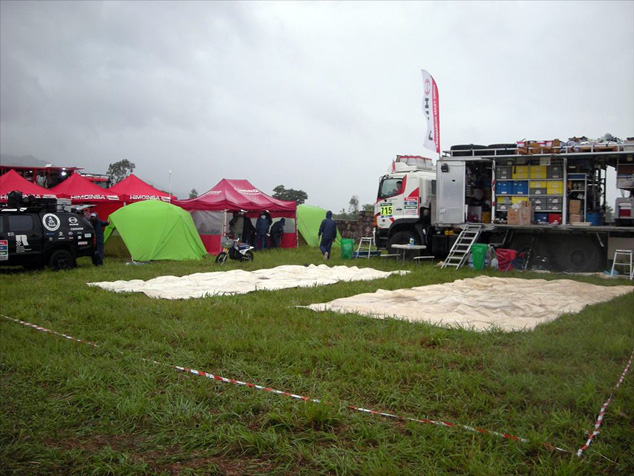
― What are your tasks once you arrive at the bivouac?
Shimazaki: The first thing we do is stake out our place. Spaces are allotted ahead of time for each team, but you can talk with the organizers and relocate to another space if any are available. For example, trucks start later in the day, so if we set up near the main road, the sound of motorbikes and cars leaving the camp earlier can wake us up. We want the drivers and navigators to get as much sleep as they can, so we try to find a quiet spot.
Tanaka: The restaurant and toilet tents are set up near the organizers’ tents, and since the bivouac is quite large, we try to get spots near the organizers so our team members don’t have to make long walks. The meals the organizers prepare for us are mostly meat-based, so we prepare meals that are more easily digestible since the drivers’ and navigators’ digestive tracts have taken a beating from being subjected to vibrations all day. Mr. Shimazaki did the rice cooking for the last rally.
Shimazaki: I would cook rice every day using a rice cooker and a portable power generator we brought from Japan, and mineral water we got from the organizers. As for main dishes, we would heat pouches of ready-made curry and chop suey toppings on our induction cookers, and serve them with hot, freshly cooked rice. The crew will start feeling fatigued in the second half of the rally, so we try to be conscious of their needs in our interactions with them.
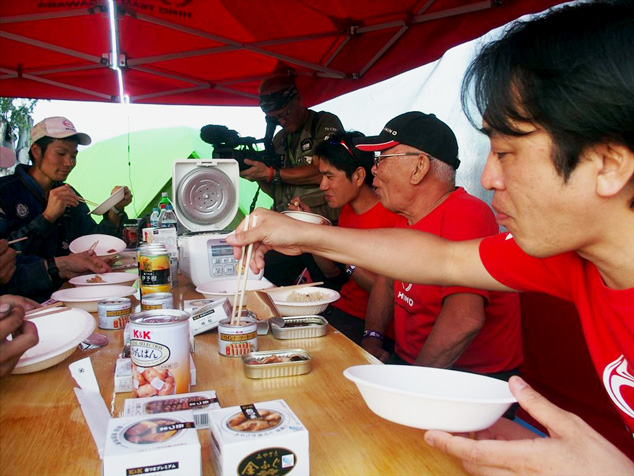
― As you get near the finish line, are there things you need to do to prepare for the ceremony?
Tanaka: We have to figure out where to wash the trucks before the ceremony, which can be a bit of a challenge because the finish line is at a different place every year and the times aren’t announced until just before the ceremony. This year, we waited on the side of a liaison segment just before the finish line and had the trucks stop over for about five minutes on the side of an agricultural road and washed them there. Once we washed the trucks, we headed for the goal, but some members of the support team couldn’t make it to the ceremony on time and weren’t able to participate because our parking spots were quite a distance away from the ceremony venue. So when you see our spick-and-span HINO500 Series trucks cross the finish line, you know we’ve been working hard behind the scenes.
― How did you end up becoming a support crew member?
Takashima: I graduated from a local university and had already received notice of employment from a company, but I realized what I really wanted to do was to go abroad. So I thought I would go to Tokyo first (laughs). When I was job hunting, I came across Mr. Sugawara’s company and thought maybe I would be able to go abroad if I worked there. I joined the company last year. I didn’t have any skills in car building, so I had to learn from scratch.
Tanaka: I was working at a local company affiliated with an automobile manufacturer. I’d been a fan of motorsports since my school days and wanted to become a mechanic or car builder, so I was looking for a new job. That’s when I came across Mr. Sugawara’s company by chance. I took a leap of faith, quit my previous job and joined the company.
Shimazaki: On the way back from the send-off party last October, one of my superiors approached me and said, “You’re on a short list of candidates for support car drivers. Will you be willing to go if you’re chosen?” I was a bit surprised, but my inspiration for joining Hino in the first place came from watching the HINO500 Series trucks racing the Dakar Rally on TV as a child, so I said, “Yes, I would like to give it a try if the opportunity comes up.”
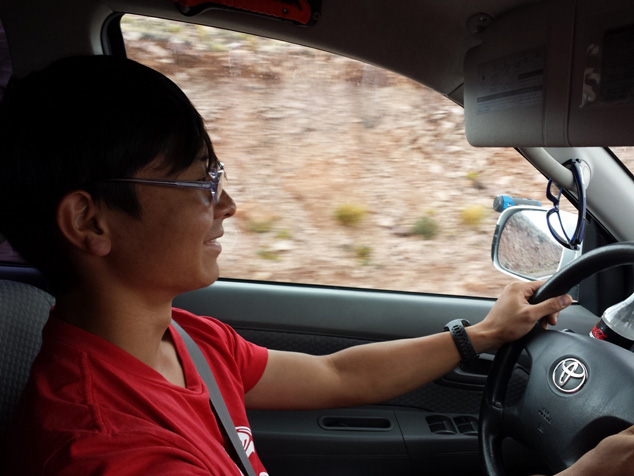
― Once you were selected as support car drivers, did you have any concerns leading up to your first rally?
Shimazaki: To tell you the truth, I was a bit anxious from the day we left Japan until we arrived in Argentina. But when I saw the HINO500 Series trucks that were shipped from Japan, it hit me that we had to bring these trucks to the finish line and win the class championship. With that thought, my anxiety was gone. I got a real sense that all the other team members were feeling the same thing, and that made me think there’s no use in feeling anxious, and even if this was my first rally, I’d do whatever I could to the best of my abilities and work together with the other team members toward that common goal.
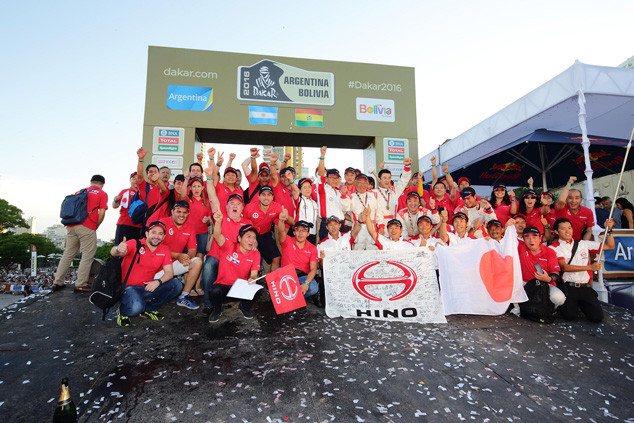
― Having actually taken part in the rally, how was it?
Shimazaki: The best thing for me was that, although I’d been reading about the rally in Dakar News, there were things you just couldn’t get from articles and photos: things like the actual temperatures, the force of the wind, and how the sun shone in different locations. The experience of seeing a sea of people from the podium at the goal ceremony as a member of the team is something you have to actually experience. Once you get a taste of that, you start to feel like you could be doing this every year (laughs).
Tanaka: I second that. Shaking hands and sharing the joy with the other team members at the goal ceremony is the moment when I feel happiest about having joined the rally team. We go through very challenging experiences during the rally, but the joy of this moment is what keeps me going until the finish line. With rallies, there’s no place to hide, so you just have to do it.
― Please tell us about your aspirations for the next rally.
Tanaka: There’s no point in entering the rally without aiming to finish in the leading group and deliver good results. When Car 2 momentarily climbed to fourth place in the last rally, I saw how everyone was so happy, and I was happy too. You get a sense of satisfaction when the trucks climb high in the rankings, so I hope to do my best as a support team member, and that we can all come together as a team with a “We’re going to win this!” attitude.
Shimazaki: My areas of focus as a support car driver have been “safe driving” and “smiles” since I’ve been told I stop smiling when I’m under pressure. I’ve been wondering what other areas I could be focusing on for the next rally, and I think it would be about being more detail-oriented in my supporting tasks. I hope I can help relax the atmosphere as much as possible, since the crew and mechanics will be working under enormous pressure.
Takashima: Team atmosphere is a huge factor in climbing up in the rankings, so I hope to be a mood-maker of sorts and help ease the tension when the going gets rough. Although this will be my first rally and I have a mixture of positive and anxious expectations, I’ll do whatever I can to support Mr. Tanaka and Mr. Shimazaki and make the best of this opportunity of working abroad as a member of the team.
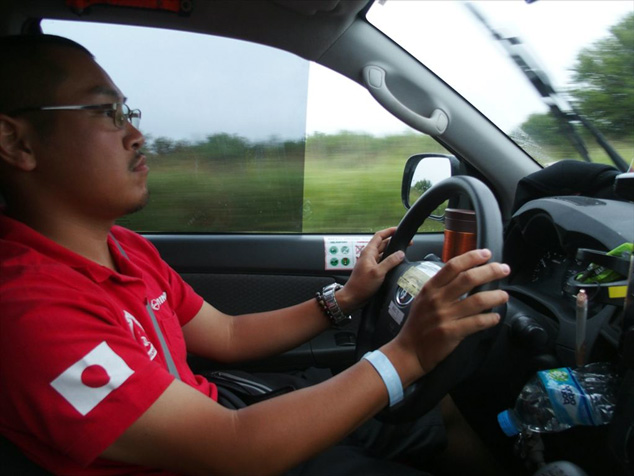
Tanaka: When people see the rally videos, you see how cool the trucks and the crew are, and I think that’s what most people focus on. So I personally feel it would be great if viewers could watch those videos knowing the support team is also there doing its work behind the scenes.
